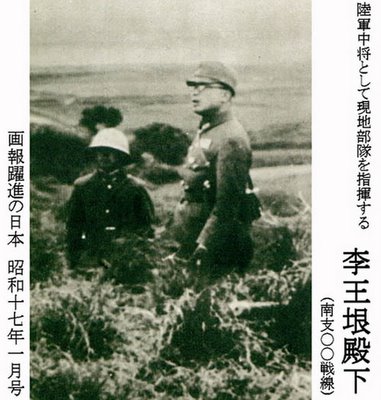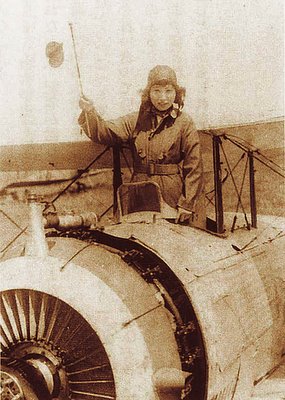The Rose is without why; She blooms, because She blooms. These roses under my window makes no reference to former roses or to better ones; they are for what they are...there is no time for them....it is perfect in every moment of its existence.
Friday, February 24, 2006
War collabolatoin under Japanese rule---Korea




Thephotos aboves are Korea soldiers.
If Koreans really wanted to to regist Japanese rule, they could do so using bayonets they were given.
Instead, Korean lieutenants took the lead and give Japanese and Korean soldiers orders to fight.
Koreans enthusiastically filled out applications for Japanese army.
link
<日本軍に支援する朝鮮人競争率>
年度……………募集人員…-………志願者…-…………競争率
year…# of the accepted…# of the applicants…the rate ofcompetitoin
1938年…………406人…- …………2,946人…-…………7.7 : 1
1939年…………613人…- …………12,348人……………20.1 : 1
1940年…………3,060人……………84,443人……………27.6 : 1
1941年…………3,208人……………144,743人 …… ……45.1 : 1
1942年…………4,077人……………254,273人 ………… 62.4 : 1
1943年…………6,300人……………303,394人 ………… 48.2 : 1
http://toron.pepper.jp/jp/20cf/image/bosyuu.gif
http://www.jacar.go.jp/cgi-bin/image.cgi?image=2&refcode=B02031284700&page=17&magnification=100
http://www.jacar.go.jp/asia_en/index_en.html
In 1943, when Toujou,A criminal , was a prime minister, more than 300000 young men volountarily applied for the army.In that year, the population of Korea was about 2500000, Let's divide it into two, so that we get the number of male.The result is 1250000. I do not know the rate of young men, but let's say half of the men were young enough and not too old for the soldiers.We get 625000.
And more than 300000 young men volountarily applied for the Japanese army, that means, about half of the young men supported the war.I mihgt be mistaken about how to evaluate the rate of young men, but you can not ignore this number.More than 300000 young men applied for the army volountarily.it might be said they were still victims of war, but they were not just passive victims of the war:you can not hide the fact that they were a part of agressors on their own wills.
Japanese mistreatment of POWS was terrible but
in ‘Prisoners of the Japanese,’ on page 104 Gavan Daws makes the following comment
“No one could imagine anything worse than a Japanese guard until Korean guards began turning up in the Southeast Asian camps.”link
And this English POW recalls,-
One had succumbed to a particularly severe bashing by Korean guards, 'some of the cruellest men in the world', who had taken over. Some relief was found with a new commandant, Sergeant Junze Higaki who spoke good English and was a Christian. He ordered the prisoners to move to another locationlink
This is from Wartime, the military history magazine published by the Australian War Memorial (Issue 32, Fourth Quarter, 2005, “An Unfamiliar Face of the Enemy” by Rosilind Hearder):
“Allied prisoners had their most frequent contact with camp guards. Many of those were conscripted Japanese soldiers, although most were actually Korean. When former prisoners of war speak of Japanese cruelty, many then note, ” . . . but the Koreans were the worst.”.........it seems there were some Korean guards who tried to ameliorate the suffering of Allied prisoners, but the majority had a bad reputation.
-Jeff
jsg /Posted 13 Nov 2006 at 11:40 am at marmot
When the Filipinos discovered that I was marrying a Korean, a couple of times they recoiled in horror, asking why would I want to do that? I soon learned that the Korean jailers were infamous for their sadistic treatment of Filipinos during the Japanese occupation of the Philippines. And at least as late as the mid 1970’s, that horrible image of Koreans remained with many Filipinos. As much as they detested the Japanese, many Filipinos hated the Koreans even more for their sadism and unnecessary crueltyTomCoynerat Marmot
 Here is a list of Korean military police who are commended by the army.
Here is a list of Korean military police who are commended by the army.
And Korean Kamikaze pilot.link

Here is pro-Japanese Korean pilot.linklink

And this is the photo of Korean people who are paying respect to the soldiers.
148 Koreans were sentenced as war crimes.link
During the war 202,341 Koreans served in Japan’s Army and Navy.
Out of this number 22,183 perished.link
Indeed, Japanese and Korea worked together in an unfortunate way.
UPDATE
Not only did Koreans collaborate with the Japanese on a basis of equality unimaginable between Africans and their European overlords, but, as Eckert makes crystal clear, Korean businessmen profited to an extreme degree from Japan's late 1930s aggressions in Manchukuo and China. Koreans were much more beneficiaries and accomplices of Japanese imperial aggression than they were the victims they prefer to see themselves as being, with Korean magnates waxing fat off Japanese imperial subsidies, tariff preferences, bank loans and orders for military equipment.Foreign Dispatches.....
Indeed, Korean industrialists even set up of their own accord a Choson Aircraft Company to manufacture planes for kamikaze attacks. Korean and Japanese cooperation in the pursuit of war production (and profits) was extremely tight.Abiola Lapite
The record of the “vigorous peninsular youth” reads as follows:*
The purpose of our travel to the mainland is entirely different from school trips. One purpose is to worship at the Ise shrine and to worship the imperial palace from a distance. Another purpose is to present ourselves to the people of the in-land and achieve an ever stronger unity between the in-land and Korea. …. We prayed for the hallowed divine nation Japan and for its continuing prosperity, and ever more firmly confirmed our desire to repay even a ten-thousandth of the sacred debt of the Emperor’s benevolent gaze that is equally bestowed upon us [isshi dojin]. We worship the east every morning at our training center and each time recite our oath as members of the Imperial nation [kokoku kokumin] as though we stood before the Emperor; in doing so, we strengthened our conviction as subjects [shinmin]. When we respectfully worshiped before the Nijūbashi Bridge, we could only weep tears of gratitude.Toa newspaper/“vigorous peninsular youth”/in the article of Kang Sang Jung
[*]Kan explains,
Precisely because of this discrimination, the unattainable “ecstatic” desire for an active decision to become “Japanese” grew ever stronger
I wonder what motivated these Koreans to have "the fervent desire to become “Japanese”in the first place.
Notes
統計
日本の厚生労働省(1990年、1993年返還名簿・当時厚生省[1])の統計によれば、朝鮮半島出身者の日本兵は24万2,341人であり、そのうち2万2,182人が第二次世界大戦で死亡または不明となり帰国していない。
表1 各地域別人員と死者等
地域.....分類.....動員.....復員.....不明又は戦没 不明又は戦没率
Area.....classification.....mobilization.....survived.... unknown/dead.....the rate
Korea
total...242,341....240,159,,,,,22,182.....9.2%
military.....116,294.....110,116.....6,178.....5.3%
militariy related worker.....126,047.....110,043......16,004.....12.7%
BCcriminals...guilty....death sentence
Koreans,,,,129.....14
経緯
[編集]
概要
下の略年表参照
1938年より陸軍特別志願兵を開始、1943年より海軍特別志願兵制度
[編集]
略年表
1872年(M6) 徴兵制度はじまる
1910年 日韓併合(韓国併合ニ関スル条約(明治43年条約第4号))
1917年 7月20日軍事扶助法(軍事救護法施行ニ関スル件(大正6年勅令第205号))
1918年 朝鮮軍人及朝鮮軍人遺族扶助令(大正7年勅令第299号)
朝鮮軍司令部条例(大正7年軍令陸第4号)
1921年 朝鮮軍軍法会議ニ関スル法律(大正10年法律第86号)
1938年
3月3日 陸軍特別志願兵領施行細則(陸軍政令第11号)
4月1日 国家総動員法(昭和13年法律第55号)→国家総動員法及戦時緊急措置法廃止法律(昭和20年法律第44号)抄録
4月2日 朝鮮総督府・陸軍病気志願者訓練所規定
朝鮮総督府・陸軍兵志願者訓錬所生徒採用規則→ 陸軍兵特別志願
5月4日公布(5月5日施行)国家総動員法ヲ朝鮮、台湾及樺太ニ施行スルノ件(昭和13年勅令第316号)
1941年 朝鮮総督府傷痍軍人療養所官制(昭和16年勅令第313号)
1943年 戦時行政特例法及許可認可等臨時措置法ヲ朝鮮、台湾及樺太ニ施行スルノ件(昭和18年勅令第242号)
7月 27日 海軍特別志願兵令(昭和18年勅令第608号),
1944年
朝鮮 徴兵検査⇒訓練中に終戦を迎える
10月28日 軍需会社法ヲ朝鮮及台湾ニ施行スルノ件(昭和19年勅令第605号)←軍需会社法 (昭和18年10月31日法律第108号)
1945年 軍事特別措置法ヲ朝鮮及台湾ニ施行スルノ件(昭和20年勅令第256号)
軍事特別措置法ヲ朝鮮及台湾ニ施行スルノ件(昭和20年勅令第256号)
戦時緊急措置法ヲ朝鮮及台湾ニ施行スルノ件(昭和20年勅令第377号)
1946年 朝鮮人、中華民国人、本島人及本籍ヲ北緯三十度以南(口之島ヲ含ム)ノ鹿児島県又ハ沖縄県ニ有スル者登録令(昭和21年厚生、内務、司法省令第1号)
1951年(昭和26年)
9月8日 対日平和条約調印(於:サンフランシスコ)
1965年 日韓基本条約調印(同年12月18日発効)
財産及び請求権に関する問題の解決並びに経済協力に関する日本国と大韓民国との間の協定調印(同年12月18日発効)
同上協定第2条の実施に伴う大韓民国等の財産権に対する措置に関する法律(法律第144号)公布(同年12月18日発効)
1987年 台湾住民である戦没者の遺族等に対する弔慰金等に関する法律(法律第105号)公布・施行
朝鮮人日本兵
Update
翻訳技術提供:株式会社クロスランゲージ、創新ソフト株式会社
전체공개로 작성된 게시물은 누구나 읽을 수 있습니다.
全体公開に作成された掲示物は誰も読めます.
일제시대 조선인 지원병 입대 경쟁율 | 근 현대 전쟁사
日帝時代朝鮮の志願兵入隊競争率 | 近現代戦争社 2006.12.13 11:44
2006.12.13 11:44
두두발(dudubal)
二頭髪(dudubal) 초보
初心者 http://cafe.naver.com/nuke928/92619
http://cafe.naver.com/nuke928/92619
아 래 knight3711님 글에 달린 yogsototh님의 댓글은 창군시 광복군의 수가 적을 수 밖에 없었음을 명확하게 보여주었습니다. 제가 파악한 바로도 해방직후 광복군은 400명 정도이고 일본군 출신은 24만명이나 되었으니까요. 조선인민군 공군도 창설 멤버들이 주로 일본군이나 만주군 출신의 조종사 정비사인것을 보면 지나가는 사람 데려다 공군조종사 시킬 수 없다는 미루님이나 능력에 따라 직위를 줘야한다는 캥거루님의 의견도 일리 있는 말씀입니다. 10만명 정도의 군대를 유지하려해도 수천명의 장교가 필요한 법인데 광복군이 다 장교로 국군에 들어 왔다 해도 소수가 될 수 밖에 없는 상황입니다.
下 の knight3711様文による yogsototh様のデッグルは創軍の時光復軍の数が少ないしかなかったことを明確に見せてくれました.私が把握したところでも解放直後光復軍は 400人位で日本軍出身は 24万名もなったからです.朝鮮人民軍空軍も創設メンバーたちが主に日本軍や満洲だね出身の操縦士整備師であるものを見れば通り過ぎる人やけどしようとし たが空軍操縦士させることができないという未塁様や能力によって職位を与えなければならないというカンガルー様の意見も一理あるお話です.10万名位の軍 隊を維持しようとしても数千名の将校が必要な法なのに光復軍がすべて将校で国軍に入って来たと言っても少数になるしかない状況です.
국군에 들어온 광복군이 적을 수 밖에 또 하나의 이유는 이 분들이 조국 광복을 목표로 하여 자신의 포부와 생업을 포기하면서 들어온 분들이기에 상당수는 더 이상 군생활을 할 이유가 없어졌다는 점도 들 수 있겠습니다. 김준엽, 윤경빈 교수처럼 학계로 가신분들도 있고 장준하 선생처럼 사회운동 하신 분도 계시고 다른 분들도 각자 그동안 미뤄왔던 다른 일도 해야 하셨을테니까요.
国 軍に入って来た光復軍が少ないの外にまた一つの理由はこの方々が祖国光復を目標にして自分の抱負と生業をあきらめながら入って来た方々だからかなり多い数 はこれ以上軍生活をする理由が消えたという点も入ることができます.キム・ズンヨップ,ユンギョングビン教授のように学界で仮身分たちもあってザングズン ハ先生のように社会運動なさった方もいらっしゃって他の方々も各各その間延ばして来た他の仕事もするとハショッウルテだから.
yogsototh님 글에 따르면 국군에 입대한 광복군 총 수는 250명이라 하셨는데 이중에는 해방후 광복군 일명 짝퉁광복군도 약간 섞여 있지 않나 조심스럽게 추측해 봅니다.
yogsototh様文によれば国軍に入隊した光復軍総数は 250人と言ったがこの中には解放の後光復軍一名チァックトンググァンボックグンもちょっとまじていないが控え目に推測して見ます.
광복군에 관한 책들을 보다 보면 항상 초모사업에 부심하는 모습들이 많이 보입니다. 간부들과 조직은 있는데 병사들 구하기가 쉽지 않았고 일제 말기에 일본군을 탈출한 조선인들이 상당수 입대하지만 1945년 4월 현재 광복군 수가 344명 정도였던것으로 파악되고 있습니다. 이런 저런 이유로 안타깝게도 광복군은 일본군과 분대 단위의 전투도 치뤄 본 적이 없습니다.
光 復軍に関する諸本を見ていればいつも招募事業に苦心する姿がたくさん見えます.幹部たちと組職はあるのに兵士ら求めやすくなかったし日製末期に日本軍を脱 出した朝鮮人たちがかなり多い数入隊するが 1945年 4月現在光復軍数価 344人ゾングドヨッドンゴッに把握されています.あらゆる理由で切なくも光復軍は日本軍と分隊単位の戦闘も受けて見た事がないです.
이와는 대조적으로 일제가 1938년부터 시행한 조선인 특별지원병 모집에서는 상상을 초월하는 경쟁율을 보여줍니다.
これとは対照的に日帝が 1938年から施行した朝鮮の特別志願兵募集では想像を超越する競争率を見せてくれます.
연도 채용수 지원자수 경쟁율
年度採用数支援自首競争率
1938 400 2946 7.7:1
1938 400 2946 7.7:1
1939 600 12348 20.6:1
1939 600 12348 20.6:1
1940 3000 84443 28.1:1
1940 3000 84443 28.1:1
1941 3000 144743 48.2:1
1941 3000 144743 48.2:1
1942 4500 254273 56.5:1
1942 4500 254273 56.5:1
1943 5330 303394 56.7:1
1943 5330 303394 56.7:1
태평양전쟁이 한창인데도 경쟁율이 50:1이 넘으니 일본 육군성 병무국장은 싱글벙글이었고 이렇게 높은 입대경쟁율은 강제징집으로 이어집니다.
太平洋戦争が真っ最中なのに競争率が 50:1が過ぎたら日本陸軍省兵務局長はにこにこだったしこんなに高い入隊競争率は強制徴集につながります.
출처 조선군사령부, 광복군연구
出処朝鮮軍司令部,光復軍研究
link
http://cafe.naver.com/ArticleRead.nhn?clubid=10030098&menuid=&searchtype=1&query=%EC%A7%80%EC%9B%90%EB%B3%91&page=&articleid=92619
Mycoree at occidentalism
<
No comments: